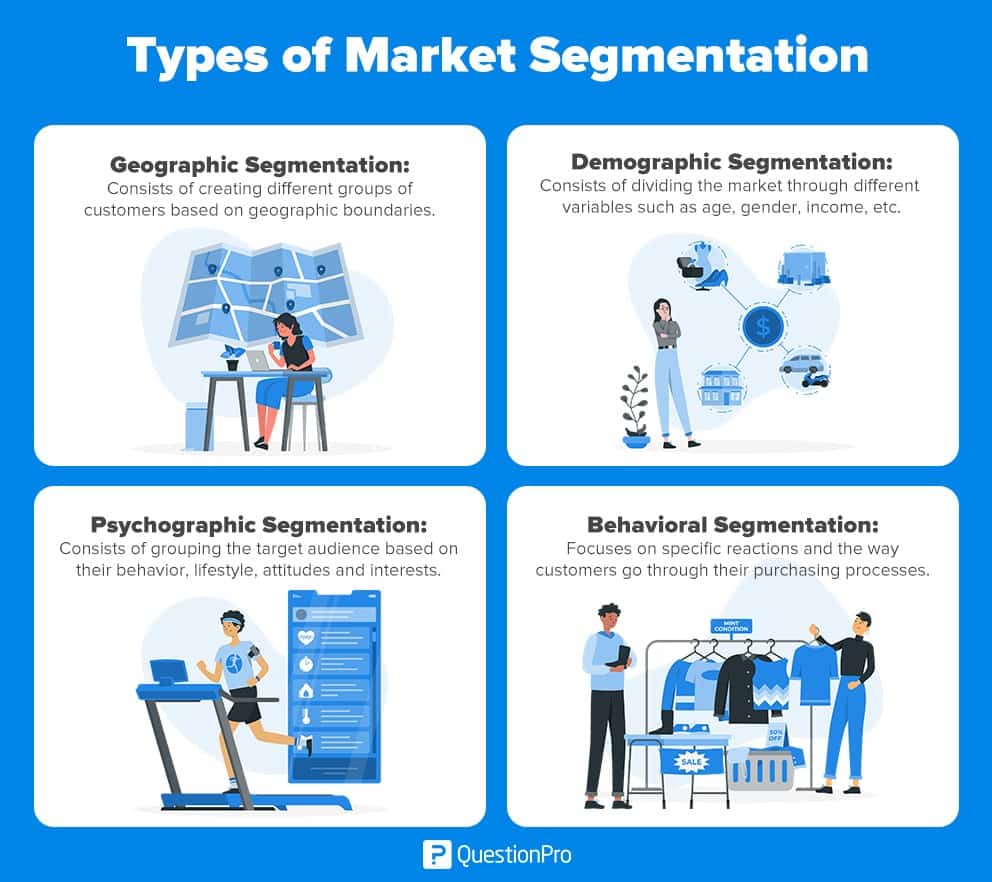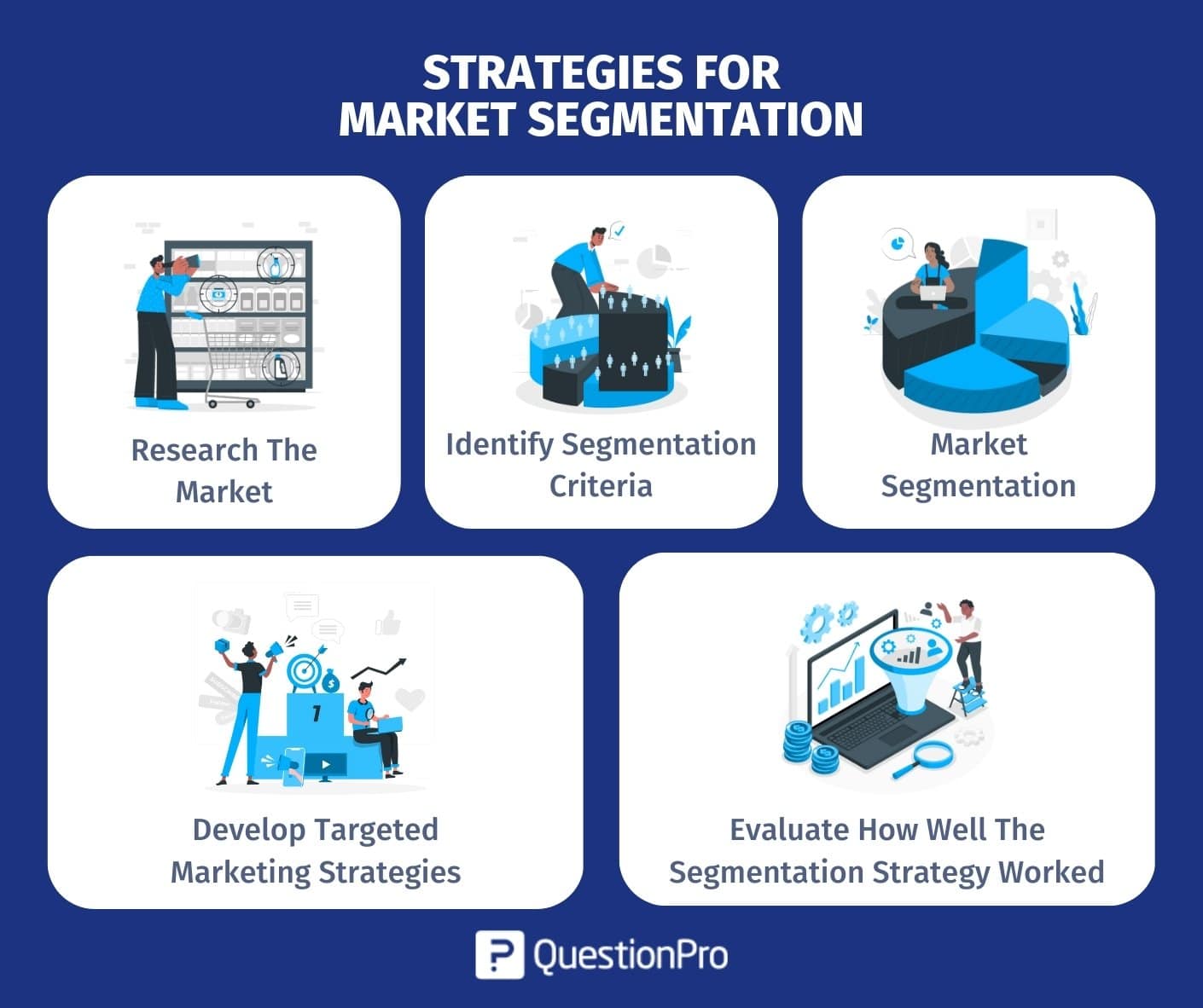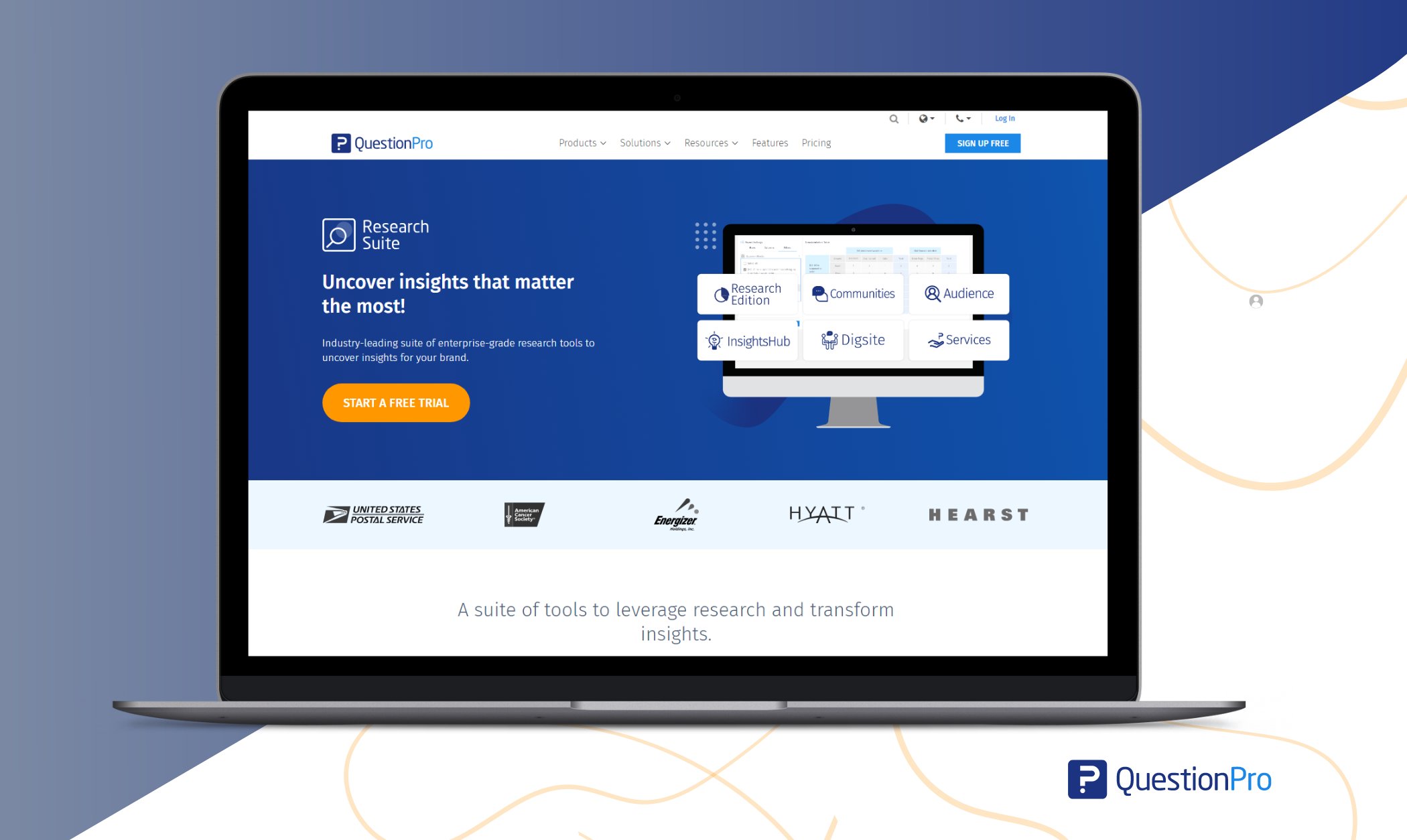
Market segmentation is the key to any long-term marketing plan that works. It is dividing a broad consumer or business market into smaller, distinct groups of individuals or organizations with similar needs, characteristics, or behaviors.
To maximize your marketing budget, you should determine why your customers buy from you by dividing your market into subgroups. Then, you’ll be better able to meet their unique needs.
Market segmentation techniques can help your business make more money because they can help you give customers more personalized experiences. Because of this, the best tools for personalization let you divide your audience into groups so you can:
- More email and text message leads
- Increase the number of sales on your website
- Improve average order values
- Increase the customer lifetime value
In this blog, we will learn what market segmentation is and how it allows you to correctly direct your marketing efforts to the right audience to ensure the success of your business.
What is Market Segmentation?
Market segmentation is a process that consists of sectioning the target market into smaller groups that share similar characteristics, such as age, income, personality traits, behavior, interests, needs, or location.
Knowing your market segmentation will help you target your product, sales, and marketing methods. It can help your product development processes by guiding how you build product offers for various groups, such as males versus women or high-income versus low-income. These segments can be used to optimize products, marketing, advertising, and sales efforts.
Segmentation allows brands to create strategies for different types of consumers, depending on how they perceive the overall value of certain products and services. In this way, they can introduce a more personalized message with the certainty that it will be received successfully.
Suppose you feel confused or need more clarity about this concept. In that case, Dani from our team has created this video to better explain the importance of segmentation in your marketing strategies.
Types of Market Segmentation
Market segmentation is the process of breaking up a large market into smaller groups of customers with similar needs, traits, or ways of behaving. There are 4 types of market segmentation. Below, we describe each of them:

01. Geographic Segmentation
Geographic segmentation consists of creating different groups of customers based on geographic boundaries.
A fast-food chain might change its menu items and specials based on what people in a certain area like. For example, they might have spicy food on the menu in places where spicy food is common.
The needs and interests of potential consumers vary according to their geographic location, climate, and region. So, geographic segmentation is valuable. Understanding geographic segmentation allows you to determine where to sell and advertise a brand and where to expand a business.
02. Demographic Segmentation
Demographic segmentation divides the market through different variables. It includes age, gender, nationality, education level, family size, occupation, income, etc.
A company that sells luxury cars might look for customers with a certain income, age, or job. For example, they might make ads for older, wealthy people who are likely to be interested in luxury cars.
Demographic segmentation is one of the most widely used forms of market segmentation since it is based on knowing how customers use your products and services and how much they are willing to pay for them. Surely demographic segmentation is very important.
03. Psychographic Segmentation
Psychographic segmentation consists of grouping the target audience based on their behavior, lifestyle, attitudes, and interests.
A fitness brand might reach customers based on how they live and who they are. For example, it might target people who like to be active and care about their health.
To understand the target audience, market research methods such as focus groups, surveys, interviews, and case studies can successfully compile psychographic segmentation conclusions.
04. Behavioral Segmentation
Behavioral segmentation focuses on specific reactions, i.e. consumer behaviors, patterns, and how customers go through their decision-making and purchasing processes.
An online store can target customers based on what they buy. For example, they might give discounts to people who buy from them often or send personalized suggestions based on what people have bought in the past.
The public’s attitudes towards your brand, how they use it, and their awareness are examples of behavioral segmentation. Collecting behavioral segmentation data is similar to finding psychographic data. This allows marketers to develop a more targeted approach.
Market Segmentation Objectives
There are different objectives for the segmentation of the market. Here we tell you what each of them is:
- Product: Creating successful products is one of the main objectives of organizations and one of the reasons why they conduct a market segment. This allows you to add the right features to your product and will also help you reduce costs to meet the needs of your target audience.
- Price: Another market segmentation objective is establishing the right price for your products. Identifying which is the public that will be willing to pay for it.
- Promotion: It helps you target each segment’s members and select them in different categories so that you can direct your strategies appropriately.
- Place: The ultimate goal of segmentation is to decide how you offer a product to each group of consumers and make it pleasant to them.
Market segmentation strategy
A market segmentation strategy is a plan for dividing a market into different segments based on certain criteria, such as demographics, geography, psychographics, and behavior. Here are some steps that businesses can take to create a good strategy for it:

1. Research the Market
Before making a segmentation strategy, it’s important to research the different parts of the target market and their needs and preferences.
2. Identify Segmentation Criteria
Based on the market segment, businesses can figure out which criteria for segmenting their target market are most important. This could include things like age, gender, income, and level of education, or it could include things like personality, lifestyle, and values.
3. Market Segmentation
Businesses can divide the market into different segments based on the criteria they have found. It’s important to ensure that each part is clear, measurable, and useful.
4. Develop Targeted Marketing Strategies
Businesses can make marketing plans for each segment when the market is divided into segments. This could mean making customized products and services, running targeted marketing campaigns, and adjusting pricing strategies to meet the needs and preferences of each segment.
5. Evaluate How Well the Segmentation Strategy Worked
Businesses should keep an eye on the performance of all the customer segments and make changes as needed to ensure the segmentation strategy works. This could mean getting customer feedback, looking at sales data, and tracking how well marketing campaigns are working.
A market segmentation strategy can help businesses better understand their customers, create targeted marketing plans, increase customer satisfaction, improve product development, increase market share, increase profits, and gain a competitive advantage.
Steps to Implement a Market Segmentation
In order to implement a strategy, you must not only know what market segmentation is. It is very important to know how to apply this method. That is why we have for you a guide that will help you:
Step: 1 – Define your market: At this point of the product segmentation, you should focus on discovering how big the market is, where your brand fits, and if your products have the capacity to solve what it promises.
Step: 2 – Segment your market: This step consists of choosing which of the types best suits your brand.
Step: 3 – Understand your market: Ask your customers the right questions, depending on the type you choose. You must know your target customer in detail. You can use online surveys to get their answers.
Step: 4 – Build your customer segments: After collecting responses, you need to perform data analysis to create dynamic segments unique to your brand.
Step: 5 – Test your strategy: Ensure you have correctly interpreted your survey data by testing it with your target audiences. This will help you to revisit your market segmentation strategies and make the necessary changes.
Step: 6 – Implement the strategies: Once the marketing plans have been tested and improved, put them into action on a larger scale.
Step: 7 – Evaluate the performance: Evaluate how well each segment and marketing strategy is doing and make changes as needed.
Step: 8 – Continue to improve: It is an ongoing process, so keep improving the segmentation criteria and marketing strategies based on customer feedback and changing market conditions.
By doing these things, businesses can effectively implement a market segmentation strategy and increase their chances of success in the marketplace.
Characteristics of Good Segmentation
Choosing the right segmentation type should ensure that the segments are relevant, accessible, measurable, profitable, and easy to use.
Different types of segmentation don’t meet these requirements in the same way. Sociodemographic criteria make it easier to get measurable segments than psychographic criteria.
Multi-criteria segmentations usually lead to a quantitative and objective description of the segment. In contrast, criteria can lead to a qualitative description of the segment that is richer and more relevant but harder to measure.
Advantages of Market Segmentation
Knowing what market segmentation is and the benefits it has for your organization will help you implement it correctly. Here are some of its advantages:
- Create stronger marketing messages: When you know who you are targeting, you can create strong, personalized messages that respond to the needs and wants of your target audience.
- Find the ideal marketing strategies: You may not know which is the right strategy to attract the ideal audience. It allows you to know the audience, create a plan that will work successfully, and determine better solutions and methods to reach them.
- Design-targeted advertising: Market segmentation allows you to target your advertising to the audience successfully and effectively, knowing their age, location, buying habits, interests, etc.
- Attract potential customers: By sending direct and clear marketing messages, you attract the right audience and are more likely to convert them into buyers.
- Differentiate your brand from the competition: By creating messages specific to your value proposition, you can stand out from the competition. Segmentation allows you to differentiate your brand by focusing on specific customer needs and characteristics.
- Identify your niche market: It helps you discover your niche market. Identify the niche with the broadest audience and whether it has needs that your brand can effectively address.
- Focus your efforts: This allows you to identify new marketing opportunities and avoid distractions that take you away from your target market.
- Create a customer connection: You can create effective strategies when you know what your customers want and need. This allows you to create strong bonds between your brand and the customer to create brand loyalty and customer satisfaction.
Disadvantages of Market Segmentation
Market segmentation can help a business in many ways but can also have some negative effects.
- Increased costs: If you want to target specific segments, you may need a bigger marketing budget to make customized products, create targeted advertising campaigns, and do a market segment.
- Overlooking potential customers: If you focus too much on specific segments, you might miss out on potential customers who don’t fit into your identified segments.
- Complexity: It can be a difficult process that requires detailed analysis and research. This can be hard for smaller businesses with fewer resources to do.
- Measuring effectiveness: It may be hard to know how effective a segmented marketing strategy is because it may not always be clear which segment is responsible for the success or failure of a campaign.
- Risk of stereotyping: There is a risk of stereotyping certain groups based on their demographic or psychological characteristics, which could lead to negative perceptions and backlash.
Businesses need to consider the pros and cons of market segmentation to decide if it’s the right strategy for their products or services.
Common Market Segmentation Mistakes
Market segmentation is one of the most important processes for ensuring that your customers receive the messages that best suit them. But every business, even the most seasoned brands in the industry, needs to fix its mistakes sooner or later, and this can also lead to ineffective marketing.
Awareness about these mistakes and how to avoid them will help in designing more targeted, effective marketing campaigns for the right audience base.
1. Ignoring Customer Behavior
Focusing solely on demographic data, such as age and income, with consideration of how customers behave or what motivates them can lead to misaligned segmentation. It’s important to include behavioral insights like purchasing habits and brand loyalty.
2. Over-Segmenting
Dividing the market into too many small segments can dilute your efforts, making it harder to create targeted campaigns. Over-segmentation may lead to a lack of focus and increased complexity in effectively reaching each group.
3. Under-Segmenting
However, segments that are too broad can overlook critical differences in needs, preferences, and behaviors. As a result, marketing campaigns may not align with specific customer segments.
4. Trusting on Outdated Data
Defining market segments using out-of-date or irrelevant data can lead to decisions based on mistaken beliefs. Keep your segmentation strategy updated based on recently available data to account for changing market trends and customer behaviors.
5. Lack of Actionable Insights
Collecting data without analyzing it and using it for marketing plans can waste resources. Ensure the segments you provide drive actionable insights that shape product development, messaging, and promotional activities.
6. Ignoring Niche Markets
In other words, avoiding smaller niche markets while chasing after massive wide ones can be a recipe for lost opportunities. Strategically targeted, though, niche markets can be some of the most profitable and loyal to your brand.
By avoiding these familiar mistakes, you can create more convincing and targeted marketing strategies that resonate with their ideal customers.
How QuestionPro Can Help in Market Segmentation?

QuestionPro is a platform for market research that offers a variety of tools to help businesses segment their markets. Here’s how QuestionPro can help:
01. Doing a Survey
Doing a survey: QuestionPro has a powerful tool for doing surveys that businesses can use to make custom surveys to collect information from their target market. Businesses can use this tool to collect customer demographics, behaviors, preferences, and more information.
02. Targeted Sampling
Targeted sampling: QuestionPro offers various sample sources so businesses can ensure their surveys reach specific parts of their target market. This includes filters based on demographics, location targeting, and more.
03. Advanced Analytics
Advanced analytics: QuestionPro has advanced analytics tools that allow businesses to analyze their survey data in depth. This includes tools for dividing data by demographics, behaviors, and preferences and making charts and graphs to show the data.
04. Advanced Reporting
QuestionPro has tools for automatic reporting that make it easy for businesses to create reports based on their survey data. This includes tools for making charts and graphs and for exporting data to Excel or other formats.
05. Integration With Other Tools
QuestionPro works with a number of other tools and platforms, like Salesforce, Slack, and Zapier, which makes it easy to use survey data in other business processes.
QuestionPro is a powerful market research platform that can help businesses with market segmentation by giving them various tools. It works for collecting, analyzing, and reporting on survey data.
Conclusion
Market segmentation is a vital strategy for businesses to identify and target specific groups within a broader audience. By dividing a market based on demographics, psychographics, geography, and behavior, companies can create more effective marketing messages, products, and services that resonate with each segment’s needs.
Effective market segmentation allows businesses to better understand their audience, remain competitive, and maximize their market potential, leading to sustainable growth and increased profitability.
Market Segmentation FAQs
Market segmentation divides customers into groups with similar traits. Marketers define their ICP through demographic, psychographic, geographic, and behavioral segmentation.
The four main types of market segmentation are:
1. Demographic
2. Psychographic
3. Geographic
4. Behavioral
Market segmentation lets organizations target specific consumer groups with their products, services, and marketing, improving efficiency and profitability.
Market segmentation helps companies target the most likely customers. Their marketing techniques are geared to these consumer segments’ demands, tastes, and behaviors.







